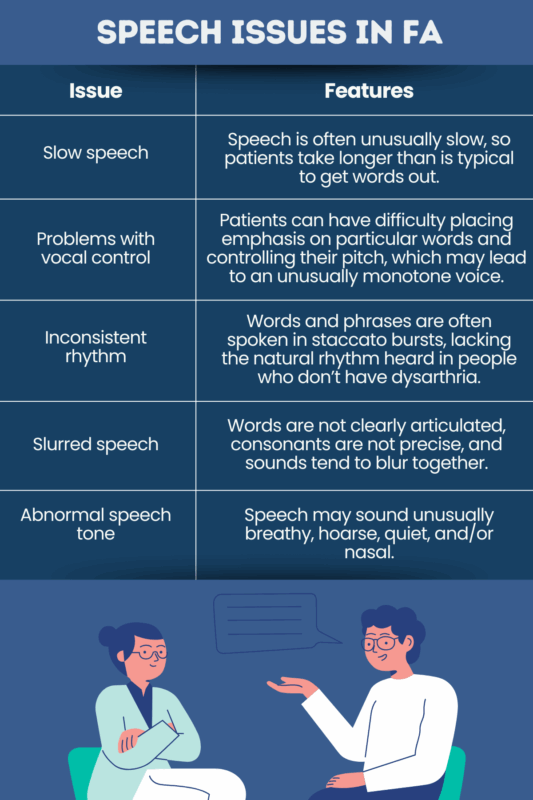Dysarthria in Friedreich’s ataxia: Managing speech changes
Last updated July 9, 2025, by Marisa Wexler, MS

Friedreich’s ataxia is a genetic disorder that causes problems with nerve and muscle cells. This often affects the tongue and other muscles in the mouth and throat, which leads to a speech abnormality known as dysarthria that is marked by issues such as slurred speech and difficulty modulating the voice.
Speech problems in Friedreich’s ataxia are very common and can make it harder to communicate, but there are a variety of strategies that can be used to help manage dysarthria and improve communication.
What is dysarthria?
Dysarthria is a general term that refers to speech abnormalities that develop when the muscles used for speech are abnormally weak or difficult to control.
Dysarthria is a motor speech disorder, as it is caused by problems with the nerves and muscles needed to move the mouth and throat muscles in order to create speech. This differentiates dysarthria from other types of speech difficulties in neurological diseases, such as aphasia (caused by issues understanding and producing language due to brain damage) and apraxia, which affects the ability to plan and execute the movements required for speech.
There are six main types of dysarthria:
- ataxic dysarthria, which is marked by difficulty articulating sounds and putting emphasis on words
- flaccid dysarthria, which causes speech to sound breathy and nasal
- spastic dysarthria, which causes speech to sound strained or harsh
- hypokinetic dysarthria, which causes slow, monotone speech
- hyperkinetic dysarthria, which is marked by fast, unpredictable speech
- mixed dysarthria, which includes features of two or more of the other five types.
Ataxic dysarthria is thought to be the main form that affects people with Friedreich’s ataxia, though they may experience a range of different types of speech issues.
How Friedreich’s ataxia affects speech
Friedreich’s ataxia is a genetic disorder marked by problems with mitochondria, which are cellular structures needed to generate energy. This especially affects nerve and muscle cells, which have high energy demands.
As a result, patients experience issues with muscle coordination and balance, a combination of symptoms referred to as ataxia. Ataxia and speech impairment are closely linked because speaking requires coordination among different muscles in the mouth and throat.
In particular, Friedreich’s ataxia frequently leads to issues with the cerebellum, which is part of the brain that helps to control movement and balance, including coordinating movements of the mouth and tongue needed for speech.
Voice changes in Friedreich’s ataxia are thought to occur mainly because of damage to the cerebellum. For this reason, dysarthria in Friedreich’s ataxia may be referred to as cerebellar dysarthria.
Specific manifestations of dysarthria in Friedreich’s ataxia include:
- unusually slow speech
- difficulty controlling the voice (for example, trouble placing emphasis or the pitch of the voice)
- inconsistent rhythm, as words and phrases may be spoken in staccato bursts
- slurred speech where consonants are not pronounced precisely and sounds are blurred together
- abnormal speech tone, with the voice sounding unusually hoarse or nasal.
Dysarthria in Friedreich’s ataxia is very common — it’s estimated that around 95% of people with the disease experience this type of speech impairment.
Most people with Friedreich’s ataxia will first experience weakness or instability in limbs, and dysarthria will begin to manifest within about two to five years after those early symptoms first appear. There can be a lot of variability from person to person, however; some people with Friedreich’s ataxia may go more than a decade after symptom onset before starting to experience voice changes.
Dysarthria in Friedreich’s ataxia is a progressive speech disorder. Over time as the disease progresses, dysarthria tends to get worse, leading to more substantial problems with speech intelligibility in Friedreich’s ataxia. Again, however, there can be substantial variability from person to person.

Diagnosing dysarthria in Friedreich’s ataxia
When someone is diagnosed with Friedreich’s ataxia, it is recommended that they undergo assessments of dysarthria regularly in neurological examinations. This is usually done by a speech-language pathologist for ataxia.
An evaluation for dysarthria will often involve standard tools, such as the assessment of intelligibility in dysarthric speakers (AIDS), the sentence intelligibility test (SIT), or the Frenchay Dysarthria Assessment.
These tests broadly involve having the person who’s being assessed say a set string of words and sounds — for example, one common assessment has the patient read a story about riding on a roller coaster. Clinicians can track how speech is affected to identify signs of dysarthria and deduce the specific dysarthria type.
It is important to detect dysarthria early and regularly monitor its progression, as this can help providers personalize the best strategies for managing dysarthria.
Strategies for managing dysarthria
Managing dysarthria and slurred speech in Friedreich’s ataxia may involve speech therapy.
Friedreich’s ataxia speech therapy may be done one-on-one or in a group, at home or in a clinical setting. The specific types of interventions may vary from person to person and over time, depending on what exactly the individual is experiencing. Some common dysarthria exercises used in speech therapy for Friedreich’s ataxia include:
- exercises to support the torso and improve breath support
- developing speech strategies to compensate for issues (e.g., speaking in short phrases to improve clarity)
- practicing finding phrasings and words that are easier to say.
Friedreich’s ataxia speech therapy also often involves modifications to the person’s environment, such as:
- reducing levels of ambient noise
- working with communication partners to make understanding easier.
If communicating clearly through speech becomes too difficult, people with Friedreich’s ataxia may benefit from assistive communication devices for dysarthria.
These include all forms of fundamental communication other than oral communication — pen and paper, pointing to letters or photos, gestures and facial expressions. High-technology aids such as an iPad, a tablet, and/or voice output also are available.
Tips for better communication
Having dysarthria can be frustrating and create challenges in social situations, but there are steps that can be taken to make communication easier. Tips for people with dysarthria include:
- be upfront about having speech issues so that new conversation partners are prepared to listen closely and be patient
- start conversations with a short word or phrase clarifying the context of what’s being discussed — for example, first saying “dinner” when starting a discussion about what to eat
- wherever possible, face conversation partners directly so they can pick up clues from body language and facial expressions
- focus on changing one aspect of speech, such as talking slower or more loudly, to improve clarity
- incorporate nonverbal methods of communication like pointing, gestures, or writing things down
- rest before and after long conversations.
Conversation partners also play important roles in facilitating good Friedreich’s ataxia communication. Tips for conversation partners include:
- paying close attention to the person who is talking
- holding conversations in locations with good lighting and minimal background noise
- watching the person who is speaking to pick up on body language and other nonverbal cues
- be clear and polite if something is not understood, and ask for something to be repeated if part of what was said is unclear
- ask yes-or-no questions or ask for gestures if speaking isn’t getting the point across.
Living with Friedreich’s ataxia and dysarthria
Living with dysarthria can be challenging. Speech difficulties can cause problems when pursuing an education and working, and may impact an individual’s quality of life.
It’s important to have realistic expectations. The vast majority of people with Friedreich’s ataxia will experience speech issues at some point, and these issues will usually get worse as time goes on.
It may be helpful to plan ahead to put in place support for when it’s needed — for example, forming an early connection with a speech therapist and becoming familiar with adaptive communication equipment before it becomes a necessity.
Although there are challenges, it is possible for people with Friedreich’s ataxia to communicate effectively and thrive in situations where communication is needed.
Friedreich’s Ataxia News is strictly a news and information website about the disease. It does not provide medical advice, diagnosis, or treatment. This content is not intended to be a substitute for professional medical advice, diagnosis, or treatment. Always seek the advice of your physician or other qualified health provider with any questions you may have regarding a medical condition. Never disregard professional medical advice or delay in seeking it because of something you have read on this website.
Recent Posts
- My FA diagnosis left me ‘thoroughly shaken,’ but I’ve found my resolve
- New MRI approach using AI may offer better picture of FA changes
- Building and maintaining friendships is an intentional act
- Using technology in an FA household to enhance care
- A getaway makes me realize FA has created a creature of comfort




